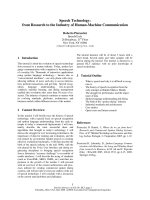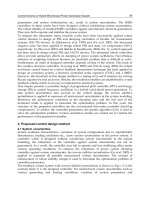From Nuremberg to The Hague - The Future of International Criminal Justice Part 7 pot
Bạn đang xem bản rút gọn của tài liệu. Xem và tải ngay bản đầy đủ của tài liệu tại đây (81.33 KB, 21 trang )
departure.There were to be many departures,conceptu-
ally and on points of detail. The individual which has
emerged is, we might say, more robust and much more
ambitious than its grandparent. But the affiliation is
certain enough, and the differences between the genera-
tions are worth analysis.
This is not the place to go into detailed issues of the
drafting of the Statute from a technical point of view.
Rather, I want to look at the underlying issues which
arose during the process of elaborating the Statute.
Formally, that process stretched from 1993 up to 1998.
Indeed, it has continued after the adoption of the
Statute, which – continuing the analogy – may be said
to have been delivered before term. Subsequent drafting
exercises have included Rules of Procedure and
Evidence and in particular the Elements of Crimes,
which elaborates at length upon the crimes within the
jurisdiction of the Court in order to provide authorita-
tive guidance to the judges in its interpretation.
2
Moreover,that process is not yet finished. It is envisaged
The drafting of the Rome Statute 111
2
Report of the Preparatory Commission for the International
Criminal Court, 2 November 2000, UN Doc. PCNICC/2000/1;
Rules of Procedure and Evidence, UN Doc. PCNICC/2000/
1/Add.1; Elements of Crimes, UN Doc. PCNICC/2000/1/Add.2.
See generally R. S. Lee (ed.), The International Criminal Court:
Elements of Crimes and Rules of Procedure and Evidence
(Transnational Publishers, Ardsley, NY, 2000).
that, in due course, there will be a further document
elaborating on the crime of aggression, which crime
will be inoperative as part of the Statute until that
happens (if it ever does).
In a deeper sense, the process of elaboration started
with the General Assembly resolution of 1946 endors-
ing the Nuremberg Charter, which envisaged that some
more permanent arrangement would be made. It
continued with the Genocide Convention of 1948,
which specifically envisaged that an international
criminal court would be established to try persons
suspected of genocide. It then went underground for a
prolonged period, only to come back to life after the end
of the Cold War, in a very different legal and political
environment but with essentially the same underlying
issues unresolved and now back once more on the
agenda.
Three underlying issues
What were those issues? I would identify three of them:
an institutional problem (how to create a real interna-
tional criminal court, with all that that implies), a legit-
imacy problem (how to validate that institution against
international law’s own demands for the rights of
112
someone accused of a serious crime) and a political
problem (how to make such a real international court
acceptable to states in general). Before discussing the
solutions adopted, I should say something about these
three problems, putting each in historical perspective.
The institutional problem
The first problem was how to bridge the enormous gap,
amounting to a chasm, between national and interna-
tional institutions and processes in the field of criminal
law.The ICC as a new institution had to be able to cope,
potentially at once, with all the practical problems of
successful investigation, prosecution, trial and punish-
ment of very serious crimes. National criminal justice
systems have evolved over many years and have the
advantage of a territorial base, a police force, prosecu-
tion services with executive power, gaols, etc. By
contrast, the ICC would be a territorially disembodied
criminal court lacking independent executive powers.
In terms of experience, it would be, metaphorically, a
child. But this child would – having regard to the seri-
ousness of the crimes and their consequences – have to
be immediately capable of acting as an adult.
This recalls a passage from one of Montesquieu’s
Persian Letters, letter 94, entitled ‘International law and
The drafting of the Rome Statute 113
its distortions’. The letter purports to be dated 1716; the
collection of letters first appeared in 1721. Here
Montesquieu is setting up an ideal of international law
as a set of universal values, against a branch of law
which ‘explains to kings how far they can violate justice
without damaging their own interests’. The allegedly
Persian writer of the letter criticises this latter version of
the subject, the Hobbesian version of raison d’état.
Drawing on an equally venerable tradition, he writes to
his friend:
You would almost think … that there were two
entirely different types of justice: one, regulating
the affairs of private individuals, rules civil law; the
other, regulating the differences that arise between
nations, tyrannizes over international law; as if
international law were not itself a kind of civil law,
not indeed the law of a particular country, but of
the world.
3
In this universalist tradition, international law is seen
as ‘a kind of civil law’, a civil law of the world. But even
the letter writer did not believe this literally: like
Grotius, he did not conceive of international institu-
tions. ‘As between citizens, judges have to administer
justice; as between nations, each nation has to adminis-
114
3
Montesquieu, Persian Letters (Penguin, revised edn, 1993), p.
176.
ter it itself.’
4
Civil law there may have been,but there was
no civil process, still less any criminal process.
According to that tradition, it might be possible, even-
tually, to establish inter-state arbitral tribunals. In effect
these were surrogate decision-makers for states who
could not or would not agree. But civil or criminal
justice was the prerogative of states.
Now it is often said or assumed that we are past all
this, that international law has moved from being an
inter-state law to being something more. Substantively
that is no doubt true, at least to some degree. But look-
ing at the question from the point of view of institu-
tions or processes, the position is much more difficult.
Indeed, some would say the chasm still exists: ‘you can’t
get there from here’, as the Punch cartoon has the coun-
try yokel telling the city motorist who stops to ask the
way to some destination.
But again, the optimist says, things have changed:
something that can be described as a real international
process has developed, not just an inter-state law about
people, but a law applicable for and to people. It is rele-
vant to recall the famous declaration of the Nuremberg
Tribunal:
The drafting of the Rome Statute 115
4
Ibid. (Letter 95).
Crimes against international law are committed by
men, not by abstract entities, and only by punishing
individuals who commit such crimes can the
provisions of international law be enforced.
5
There was some element of circularity in the word
‘only’, since international law is enforced and applied
daily against abstract entities. But of course it is not
enforced by criminal process.The idea that states as such
can be subject to criminal process or punishment has
gained very little acceptance, and it was deliberately
rejected by the ILC in its Articles on Responsibility of
States for Internationally Wrongful Acts (2001).What the
Nuremberg Tribunal seems to have been saying is that the
only way of enforcing international criminal law is by
punishing the individuals who commit those crimes.But
the question it faced was whether there was any interna-
tional criminal law,properly so-called,and that question
was not answered by declaring that international crimi-
nal law can only be enforced against individuals.
When the optimist is pressed to justify this optimism
about the existence of a real international process capa-
ble of bridging the chasm between the inter-state and
the human dimensions, two examples are usually given.
116
5
International Military Tribunal (Nuremberg), Judgment and
Sentences, (1947) 41 American Journal of International Law 172
at 221.
The first is the post-Nuremberg development of inter-
national criminal law. The second is the development
not merely of human rights standards but of interna-
tional courts and committees before which individuals
have standing to invoke international law.
These are no doubt striking developments, but how
far they go in the direction of a real international
process is less clear. One might argue that they make it
more difficult. The first development has, paradoxi-
cally, made it more difficult to solve the institutional
problem. The second difficulty has, paradoxically,made
it more difficult to solve the rule of law problem.
As to international criminal law, when the
Nuremberg Charter was adopted in 1945, there was
little by way of a set of international criminal laws
appropriate for application by an international war
crimes tribunal. Moreover, the crimes in the
Nuremberg Charter – waging aggressive war, war
crimes and associated crimes against humanity – were
applicable only to selected defeated belligerents in the
war.The charges of victor’s justice and retrospective law
were made at the time, and were a source of unease.
Attempts were accordingly made to institute and gener-
alise the outcome of Nuremberg, and three things were
done in the period to 1950 to achieve that. First, the
General Assembly in a non-binding resolution
The drafting of the Rome Statute 117
endorsed the Nuremberg Charter and expressed the
view that the substantive crimes embodied in the
Charter reflected customary international law.
6
Secondly, the Genocide Convention of 1948 elaborated
the first and worst of the crimes against humanity as a
specific crime.
7
Thirdly, the 1949 Geneva Conventions
provided a reasonably comprehensive set of rules for
the conduct of international armed conflict, grave
breaches of which were to be punishable by states
parties before their own courts or military tribunals.
The 1949 Conventions also provided embryonically for
standards of conduct in internal armed conflict,
although they made provision for implementation or
punishment.
8
118
6
See the Charter of the International Military Tribunal, (1945) 39
American Journal of Inter
national Law
, Supplement of Official
Documents, p. 258; endorsed by the UN Gener
al Assembly in
General Assembly Resolution 95 (I) of 11 December 1946.
7
Convention on the Prevention and Punishment of the Crime of
Genocide, 9 December 1948, General Assembly Resolution 260
(III) A, 78 UNTS 277.
8
Geneva Convention for the Amelioration of the Condition of
the Wounded and Sick in Armed Forces in the Field, 12 August
1949, 75 UNTS 31; Geneva Convention for the Amelioration of
the Condition of Wounded, Sick and Shipwrecked Members of
Armed Forces at Sea, 12 August 1949, 75 UNTS 85; Geneva
Convention Relative to the Treatment of Prisoners of War, 12
August 1949, 75 UNTS 135; and Geneva Convention Relative to
the Protection of Civilian Persons in Time of War, 12 August
1949, 75 UNTS 287.
In the early 1950s, work was underway on two further
steps towards an international criminal jurisdiction – a
study by the ILC on the possibility of an international
criminal court, and a General Assembly working group
on the definition of aggression. This was the situation
when the curtain of the Cold War came down, and these
new steps were frustrated. The ILC reported on the
possibility of an international criminal court, and its
report was shelved.
9
The General Assembly sub-
committee laboured for years on the definition of
aggression, producing eventually, in 1974, a text of such
vagueness and imprecision as to be incapable of practi-
cal application in any difficult case.
10
There the issue of
an international criminal court remained.
Instead, international criminal law developments
flowed into new channels. Starting with the Single
Convention on Narcotic Drugs,
11
a long line of treaties
dealt with the suppression of crimes of international
The drafting of the Rome Statute 119
9
Report of the International Law Co
mmission on the Question
of International Criminal Jurisdiction, UN Doc.
A/CN.4/15
(1950),
reprinted in
Yearbook o
f the International Law
Commission 1950, vol. II, p. 1.
10
General Assembly Resolution 3314 (XXIX), Definition of
Aggression, 14 December 1974.
11
Single Convention on Narcotic Drugs, New York, 30 March
1961, 520 UNTS 151; reprinted as amended by the Protocol
Amending the Single Convention on Narcotic Drugs, New York,
8 August 1975, 976 UNTS 105.
concern. They covered drug trafficking, aircraft hijack-
ing and other crimes against civil aviation, ship hijack-
ing, a range of specifically defined terrorist crimes, and
a number of other miscellaneous matters such as state
torture and the employment of mercenaries. These
suppression treaties did not seek to be comprehensive.
They dealt with different questions, one after another.
But there were many of them, and over time they came
to cover much of the field of crimes of international
concern. When events occurred which showed that
there were gaps in coverage, they might be filled, as with
the convention on ship hijacking of 1988, which
followed the Achille Lauro affair.
12
In a number of areas
there were supplementary conventions which were
more comprehensive and ambitious in their coverage,
in particular drug trafficking and, more recently, terror-
ism. (It has still not proved possible to produce a
comprehensive definition of terrorism, but the patch-
work definition of terrorism provided by the existing
conventions has served almost the same function. It
does not, however, cover crashing jet planes into
skyscrapers, unless one classifies the planes as bombs.)
120
12
Convention on the Suppression of Unlawful Acts Against the
Safety of Maritime Navigation, Rome, 10 March 1988, 1678
UNTS 221. See also A. Cassese, Terrorism, Politics and Law: The
Achille Lauro Affair (Polity Press, Cambridge, 1989).
On the whole, these developments took us further
away from, not closer to, an international criminal
court. Indeed, it is not too much to say that the devel-
opment of international criminal law from the 1950s
until the early 1990s was a development away from
international to national jurisdiction. The original idea
of generalising Nuremberg faded quickly. Before 1998,
there were only two references in treaties to an interna-
tional criminal court to be established – in Article VI of
the Genocide Convention of 1948, repeated in Article V
of the much less accepted Apartheid Convention of
1973. Instead of international jurisdiction, the suppres-
sion treaties worked on the basis of national courts
exercising extended (but not universal
13
) jurisdiction,
and they applied without prejudice to the concurrent or
more extensive jurisdiction of national courts over
locally defined crimes. In terms of international
process, the suppression treaties focused on inter-state
co-operation and extended national jurisdiction. Thus
the international instruments effectively provided for
the extension of national process and jurisdiction.
There was no international criminal process as such.
When the international criminal court idea took off
The drafting of the Rome Statute 121
13
As noted by President Guillaume in the Arrest Warrant Case
(Democratic Republic of the Congo v. Belgium), Judgment of 14
February 2002, Separate Opinion, especially para. 16.
again in the 1990s, it was against the trend of develop-
ment of the previous forty years.
14
Moreover, because these international treaties
focused on national courts and conferred supplemen-
tary, non-exclusive jurisdiction, they did not need to
focus very clearly on any threshold for jurisdiction in
terms of the gravity or systematic character of the
crimes covered. Individual acts covered by the suppres-
sion treaties could be relatively routine or minor (e.g.
most forms of retail drug trafficking), or at least they
could be not very different in quality from serious
national crimes (e.g. local acts of terrorism).
Jurisdiction over them might be extended, but the acts
themselves, considered in isolation, were nothing out of
the ordinary. By contrast, an international criminal
court could not possibly be given jurisdiction over run-
of-the-mill drug trafficking cases or it would risk being
swamped. Clearly, a high threshold for ICC jurisdiction
was required – yet that threshold was not articulated in
the suppression treaties, which made up the bulk of
international criminal law.
It is true that there had been a few developments at the
upper end of the scale of international gravity, to go
alongside the Genocide Convention and the four
122
14
See generally D. McClean, International Co-operation in Civil
and Criminal Matters (Oxford University Press, Oxford, 2002).
Geneva Conventions of 1949. But these made only
limited progress. The two 1977 Protocols to the Geneva
Conventions developed the range of prohibitions in the
field of international and to a lesser extent internal
armed conflict, but did not add any new institutional
elements of any significance.
15
The 1973 Convention on
the Suppression and Punishment of the Crime of
Apartheid treated apartheid as a separate and special
phenomenon, confined essentially to southern Africa.
16
This was politically understandable at the time, but it
tended to separate the crime of apartheid from its proper
conceptual basis as a crime against humanity – that is to
say, as a systematic crime involving large-scale,violent or
coercive oppression of one human group by another.
Moreover, there were serious gaps. The attempt to
define aggression had run into the sands. The scope of
the international law concerning the conduct of inter-
nal armed conflict was still rudimentary, contested and
lacking any form of enforcement provision. There was
The drafting of the Rome Statute 123
15
Protocol Additional to the Geneva Conventions of 12 August
1949, and Relating to the Protection of Victims of International
Armed Conflicts (Protocol I), Geneva, 8 June 1977, 1125 UNTS
3; Protocol Additional to the Geneva Conventions of 12 August
1949, and Relating to the Protection of Victims of Non-
International Armed Conflicts (Protocol II), Geneva, 8 June
1977, 1125 UNTS 609.
16
International Convention on the S
uppression and Punishment
of the Crime of Apartheid, 30 November 1973, 1015 UNTS 243.
no agreed international definition of crimes against
humanity, still less a convention dealing with that
subject. Yet (with the possible exception of terrorism,
which itself had escaped comprehensive definition) the
two most common and most serious problems, at the
high end of the spectrum of international crimes, were
crimes against humanity and war crimes in internal
armed conflict. Moreover, while the suppression
conventions had been quite widely used as part of the
fight against transboundary crime, the enforcement of
the international law prohibitions against genocide and
international war crimes was minimal. Only in a hand-
ful of cases (Eichmann, Calley) were these rules
enforced at all. Large-scale crimes in Cambodia and
elsewhere (crimes against humanity at least, possibly
genocide) had gone entirely unaddressed.
To summarise, the institutional problem in the early
1990s was huge. There had been no experience of the
international administration of criminal justice since
the 1940s. Attempts to establish an international crimi-
nal court had run into the sands and were widely seen as
utopian. International criminal law had developed in a
different direction, and the enforcement of crimes
which were inherently international in character or
context (genocide, war crimes) had been almost
entirely ineffective.
124
The rule of law problem
Then there is a second, related problem. An interna-
tional criminal court would have to be seen as legiti-
mate, to comply with standards for the rule of law
which we have come to expect from national criminal
justice systems. Yet it would (probably) only operate on
an occasional basis. This created an issue for interna-
tional human rights and the rule of law. It was of partic-
ular importance in criminal cases. The major interna-
tional human rights treaties – the International
Covenant of 1966, the European Convention on
Human Rights and Fundamental Freedoms, etc. – give
ten times as much attention to criminal as to civil
justice. Surely an international criminal tribunal must
comply with international law’s own standards for
criminal law in general? For example, could it be an
occasional institution which was at the same time
‘established by law’?
This was not the lesson international criminal
lawyers drew from international human rights instru-
ments. At least there were international human rights
courts and committees where the individual had stand-
ing – the European Court of Human Rights, for exam-
ple. Here, it was said, was a process of sorts, involving
both the state and individuals as parties asserting their
The drafting of the Rome Statute 125
own rights. But the analogy is misleading. International
human rights processes pit the individual against the
state (not vice versa), and human rights operate – as
they operate to a large extent even under the UK
Human Rights Act 1998 – as a critical standard for the
assessment of and eventually for remedying deficiencies
in national law. They are not first order rules of
conduct, in the way that criminal law rules are.
This is not to decry human rights law, which has been
incrementally a huge force for change in the modern
period. But international human rights courts still do
not involve the civil process envisaged by Montesquieu,
still less any criminal process. In practice, there has been
no international process by which states could call
individuals to account, and this omission was
deliberate.
17
There can, for example, be no
counterclaims for breach of international standards
brought against individual claimants, whether before
human rights tribunals or (it seems) in direct recourse
arbitration under bilateral investment treaties.
18
These
fora are essentially unilateral, against the state which
126
17
For the application of human rights standards to non-state enti-
ties, see generally A. Clapham, Human Rights in the Private
Sphere (Clarendon Press, Oxford, 1993).
18
As to which see J. Paulsson,‘Arbitration Without Privity’ (1995)
10 ICSID Review-FILJ 232.
has joined in establishing them and which has
consented to be sued. By confining the individual to the
role of claimant the problem of due process is side-
stepped. The individual consents to the system in the
very act of invoking it. But no one consents to be a
criminal accused.
The existence of international human rights courts,
especially the European Court of Human Rights, may
have had some value in showing the possibility of
standing mixed tribunals at the international level. But
they were a far cry from an international criminal
court. And, in the field of criminal law, the critical
standard, as it has developed in the human rights
jurisprudence, makes it difficult indeed for an interna-
tional tribunal. In particular, criminal courts must be
‘established by law’ and must follow the rule of law.
How could an international criminal court be ‘estab-
lished by law’ when it would lack many features of
national criminal justice systems? For example, its
power to compel evidence would be limited. In terms
of its functioning it was likely to be an occasional
court. Only a few of the possible cases would be likely
to come before it, yet the basis for selecting these was
unclear and might well be arbitrary. Even venerable
national institutions – for example, the conseils d’état
of Luxembourg and other countries – have been held
The drafting of the Rome Statute 127
not to be established by law but to need significant
reform.
19
So to the age-old structural problem was added a rule
of law problem: were we to establish international crim-
inal processes that did not meet international law’s
standards for criminal processes anywhere? That would
be a curious form of universalism. Or, in moving to an
international criminal process, were we to make an
exception, to fall below our own standards? It may seem
that we are unable to get there from here. As Churchill is
reputed to have said, it is unsafe and unsatisfactory to
leap a chasm in two bounds. And yet it might seem
impossible to leap it in one.
It is true that there are occasions which cry out for
some form of international trial process. But when we
establish international criminal courts we are haunted
by the rule of law problem, as Nuremberg and Tokyo
were haunted.Are these courts established by law? Is this
victor’s justice? Is this criminal law in truth retrospective,
since international law has never been accompanied by
international criminal process and we have instead relied
on national law to legitimise trials? It has not taken much
128
19
See Procola v. Luxembourg, Judgment, 28 September 1995,
ECHR, Application No. 14570/89; and McGonnell v. United
Kingdom, Judgment, 8 February 2000, ECHR, Application No.
28488/95.
imagination for Mr Milosevic’s counsellors to think of
these points.They have been often made before,in Judge
Pal’s dissent at Tokyo, for example, and in the conscien-
tious concerns of other lawyers who nonetheless voted
‘
yes’to convictions at those trials.
20
After 1989, the same old issues emerged out of cold
war storage, you might say. The Yugoslavia and Rwanda
Tribunals were the Nuremberg and Tokyo Tribunals of
our time, and they raised exactly similar concerns, but
now they did so against the very human rights stan-
dards which had been perhaps the greatest interna-
tional achievement of the preceding forty years.
How did the new ad hoc tribunals respond when their
legitimacy was queried against these standards?
Essentially in two ways: on the military tribunal anal-
ogy; and on the basis that the international arena is
special, and is not subject to international standards
applicable to national courts. The challenge was raised
before the ICTY Appeals Chamber in an early case,
Prosecutor v. Tadic.
21
It was argued that, because the
The drafting of the Rome Statute 129
20
See R. N. Sanyal (ed.), International Military Tribunal for the Far
East: Dissentient Judgment of Justice Pal (Sanyal & Co., Calcutta,
1953), pp. 697–701. See also B. V. A. Röling and A. Cassese, The
Tokyo Trial and Beyond: Reflections of a Peacemonger (Polity
Press, Cambridge, 1993).
21
Prosecutor v. Tadic (Jurisdiction), Appeals Chamber, 2 October
1995, 106 ILR 453.
ICTY was established as an occasional ad hoc body by a
Security Council resolution, it was not established by
law as required by the International Covenant or the
European Convention on Human Rights. The Appeals
Chamber responded as follows:
[The] appellant has not satisfied this Chamber that
the requirements laid down in these … conventions
must apply not only in the context of national legal
systems but also with respect to proceedings
conducted before an international court. This
Chamber is … satisfied that the principle that a
tribunal must be established by
law … is a general
principle of law imposing an international obliga-
tion which only applies to the administration of
criminal justice in a municipal setting. It follows
from this principle that it is incumbent on all States
to organise their system of criminal justice in such a
way as to ensure that all individuals are guaranteed
the right to have a criminal charge determined by a
tribunal established by law.This does not entail,
however,that,by contrast,an international criminal
court could be set up at the mere whim of a group of
governments. Such a court ought to be rooted in the
rule of law and offer all guarantees embodied in the
relevant international instruments. Then the court
may be said to be ‘established by law’.
22
There are several problems with this. It seems wrong in
principle to say that international criminal process is
130
22
Ibid., pp. 472–3.
subject to a lesser standard than national criminal
process. This is certainly true when we conceive of the
relevant values as human rights. How can my right to be
tried by an impartial and independent tribunal estab-
lished by law be abrogated because the tribunal is estab-
lished at the international level? Are states free to violate
international human rights when they hunt in packs – so
to speak? It is true that there are institutional difficulties
when conduct affecting individual rights is carried out
not by states but by international organisations,that is,by
associations of states. The European Court of Human
Rights has no jurisdiction over the European Union or
over NATO, and the conduct in question may be attrib-
uted to the collectivity,not to its members.
23
But it is one
thing to admit to an institutional gap and another to say
that the underlying standard is inapplicable in princi-
ple.
24
Anyway, there was no obvious institutional gap for
The drafting of the Rome Statute 131
23
Bankovic v. Belgium and 16 Other Contracting States, Decision
on Admissibility, 12 December 2001, ECHR, Application No.
52207/99.
24
See generally P. Klein, La Responsabilité des Organisations
Internationales dans les Ordres Juridiques Internes et en Droit des
Gens (Bruylant, Brussels, 1998); A. Reinisch, International
Organizations Before National Courts (Cambridge University
Press, Cambridge, 2000); P. Sands and P. Klein, Bowett’s Law of
International Institutions (Sweet & Maxwell, London, 2001); K.
Wellens, Remedies Against International Organisations
(Cambridge University Press,Cambridge,2002).









